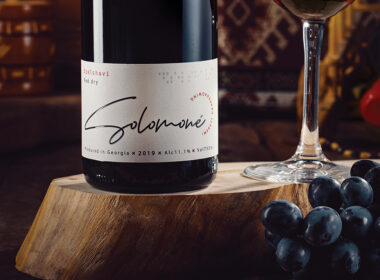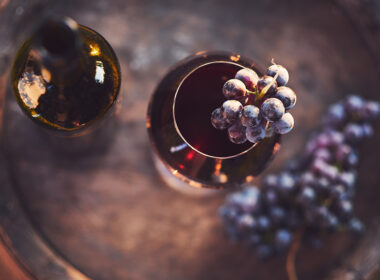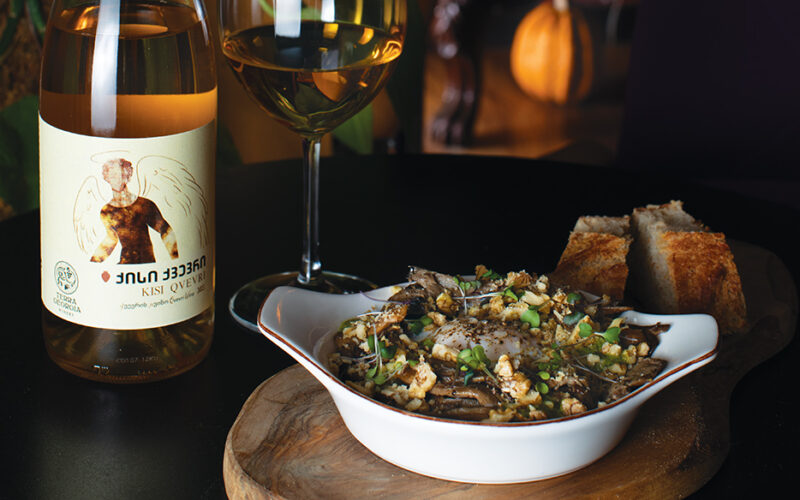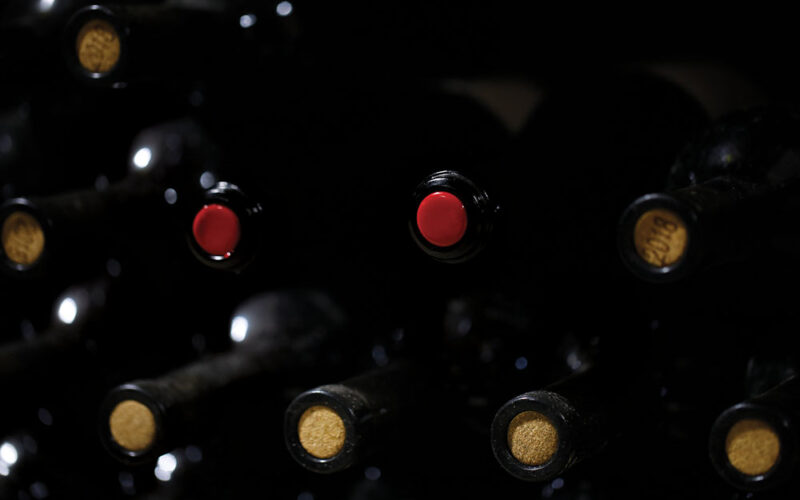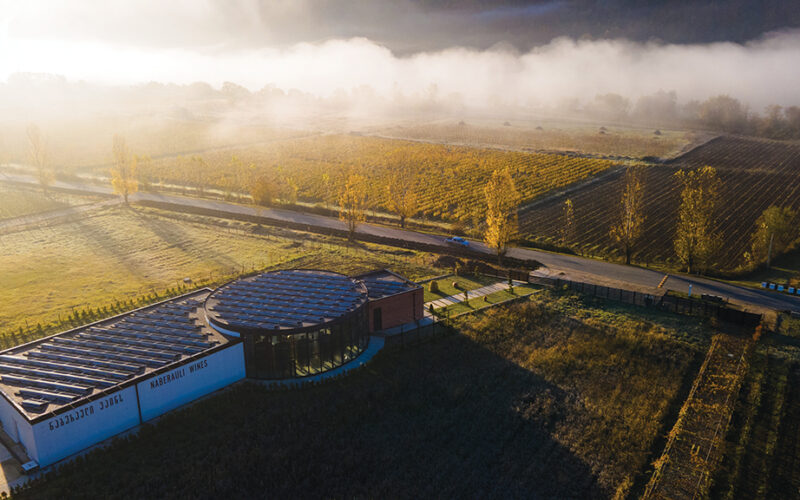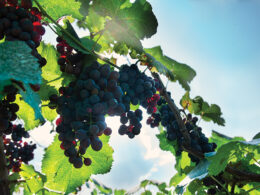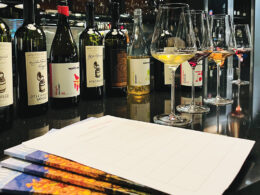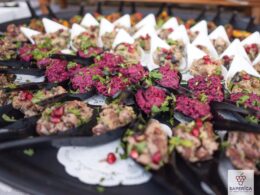| Homeland of Wine Magazine |

Tazo Tamazashvili | Best Sommelier of Georgia
When Georgia—a country with an unbroken 8,000-year tradition of winemaking in qvevri—entered the international market with its qvevri wines, it was an unexpected discovery for foreign consumers. Adapting to this unique style took time. Today, the landscape has shifted—interest in Georgian wine and its demand are growing. Natural winemaking has become a global trend, particularly in countries like France, Germany, Austria, Italy, Spain, the U.S., and Scandinavia. Qvevri and churi wines naturally align with this movement.
Georgian wine has already made its way onto the shelves of leading wine markets, yet a key challenge remains—ensuring that foreign consumers better understand what makes it unique and how to define its style. At various international exhibitions and trade fairs, whether as a guest or participant, I often hear a common reaction when presenting Georgian wine: “This is the first time I’m tasting a white wine made with skin contact.” This remark may come from an enthusiast rather than a professional, but it is wine enthusiasts who shape the market for our wines.
There is a shared understanding that Georgian wine should be introduced to both professionals and enthusiasts in settings, festivals, and exhibitions where there is a deep understanding of wine.
Together with my colleagues, wine experts Daria Kholodilina and Rezi Tsetskhladze, I will share insights on the current challenges facing Georgian wine and the key steps we must take to foster its growth and strengthen its position in international markets.
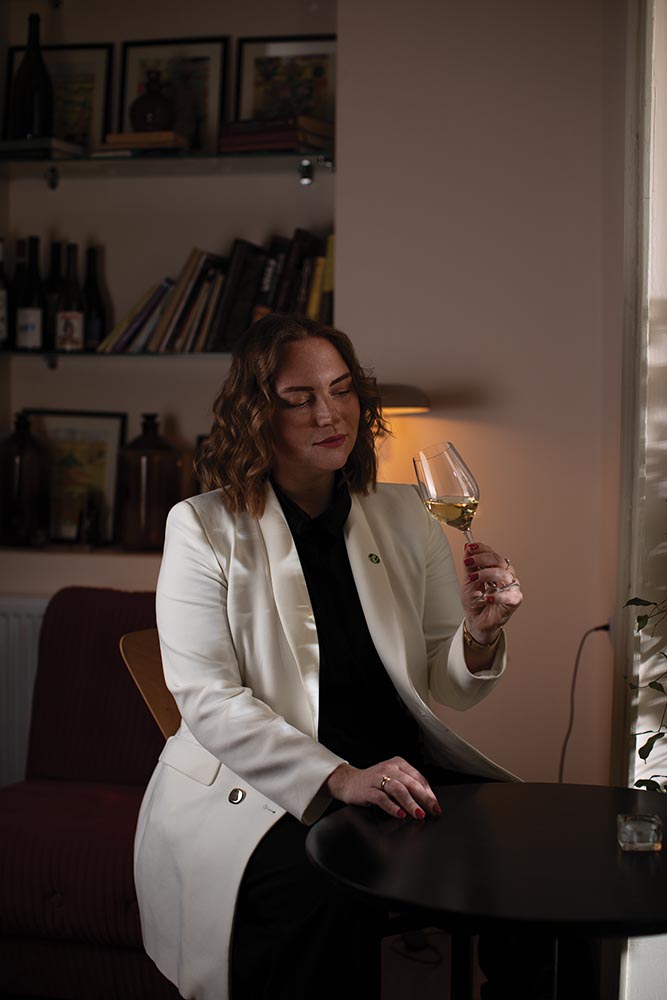
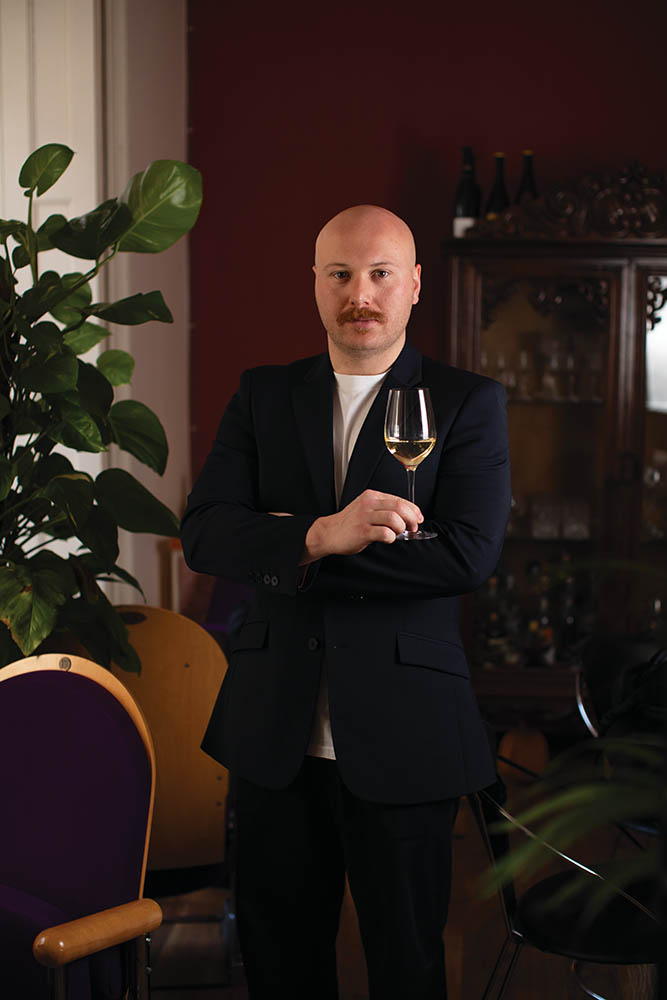
There are several great examples from European countries that have successfully maintained their positions in the global market through effective strategies. Austria, for instance, is known for its high-quality wines, including natural and organic varieties. Austrian winemakers once formed a union/commune, and their wines can be easily identified by the Austrian flag on the corks and capsules. This union has become a key partner in numerous important events, and their wines are tasted and evaluated at prestigious sommelier competitions and other major events worldwide.This is a strong and noteworthy example for a country like ours, which, despite its long winemaking history, is only now stepping into global markets due to past challenges.
Daria Kholodilina: It’s essential to provide foreign consumers with more information about the wines they are choosing. In my lectures abroad, I emphasise the stylistic diversity of Georgian wine. Georgia offers a classic wine style, various types of qvevri and churi wines, and a wide range of red wines. This diversity, however, must always be accompanied by consistent high quality. When a wine enthusiast selects your wine, they become a loyal customer. It’s crucial that they expect quality in every bottle, and if that expectation isn’t met, they will undoubtedly turn to another option. Quality and consistency are fundamental for growth, creating the opportunity for Georgian wines to gain a stronger presence in Europe, America, and Asian markets like Korea and Japan. Asian consumers, for example, are always keen to explore gastronomic trends, making Japan and Korea key markets for Georgian wine. There’s still much work to be done in these regions. Moreover, Georgian wine pairs beautifully with the diverse flavours of Asian cuisine.
Scandinavian countries are also of great interest, as they are home to a gastronomically curious population. Georgian wine will truly be a discovery for them. Similarly, the United Kingdom has wine-loving clusters that are well-versed in classic regions but are always eager to explore new wines.
Rezi Tsetskhladze | Wine Expert | Winemaker (Winery Pery): There is still much work to be done, and it must be carried out step by step and with careful consideration to strengthen our positions in key markets. Every year, numerous festivals and exhibitions take place where Georgian winemakers and wine ambassadors participate. Wine buyers and bloggers also visit our country regularly, but this alone is not enough. We must focus on taking more meaningful and impactful actions that will create greater opportunities for Georgian winemakers.
Correct positioning in international markets and the accurate delivery of information is vital — for example, explaining the difference between white Rkatsiteli made using traditional methods and amber Rkatsiteli. Consumers must always have a clear understanding of the type of wine they are dealing with.
Tazo cited Austria as an example, where, like other leading countries, everything has a clearly defined name. In contrast, Georgia lacks standardization, which, to some extent, is quite appealing as it gives winemakers more freedom. This freedom, in turn, encourages creativity and innovation. However, I believe it is important to establish certain boundaries to clearly communicate to wine consumers in different countries what each bottle contains. This would greatly simplify sales.
Tazo Tamazashvili: Recent statistics show that global wine consumption is declining, and this trend primarily impacts countries like ours. While Georgia’s rich history, unique qvevri winemaking technique, diverse grape varieties (525 endemic species), five wine regions, and 30 Protected Designations of Origin (PDO) are undeniably our strengths, they alone are not enough to secure a solid position in the global market. Significant and focused efforts are needed to ensure that Georgian wine is appropriately priced and remains competitive with the best wines from other leading countries.
The establishment of winemaker associations will positively impact the process, as they can define the characteristics that each grape variety should possess. For example, it is not desirable for an Imeretian wine made in the Kakhetian style using qvevri to be marketed as Imeretian. In such cases, the two regional styles clash, which benefits neither.
Eastern and Western Georgia differ in terroir, grape varieties, winemaking techniques, and standards (qvevri in the East, churi in the West). This is another unique strength of our country. It is not necessary to apply a single standard across all regions, as this would be counterproductive.
These processes will be most effectively managed through winemaker associations, or communes, which will help establish appropriate frameworks and encourage standardization. This approach proved successful for Old World countries when New World regions (such as Australia, Chile, New Zealand, and Argentina) entered the market with highly aromatic, effective wines at competitive prices, resonating with consumers. This shift led Old World countries to form winemaker associations, with Italy serving as an excellent example.
More scientific research is needed to identify the distinctive characteristics of our grape varieties, and this should not be limited to Saperavi alone. While Saperavi is a leading red grape variety, it produces wines of varying styles (as it is terroir-dependent) — dark-coloured, full-bodied, tannic wines with specific aromatic profiles. However, alongside Saperavi, we need to promote other red grape varieties from both Central and Western Georgia. Our country should not be known for just one dominant red variety.
Daria Kholodilina: Given the growing demand for light-bodied red wines, Georgia offers a rich diversity of such grape varieties, providing the potential to produce wines with lower alcohol content that are light and perfect for everyday consumption.
Tazo Tamazashvili: We are now entering a competitive phase on the international shelf, and it’s crucial that we carefully study its principles to define our position. We need to determine where we want to establish ourselves and identify potential markets to focus our efforts. Georgian producers should be given more opportunities to position themselves in European, American, and Asian markets, enabling them to communicate with wine professionals and enthusiasts about their wines—covering everything from terroir and soil to grape varieties and winemaking techniques.
We have numerous opportunities at our disposal, and it’s essential that we capitalize on them to provide the global consumer with accurate information about Georgian wine.
Pairing Food and Wine
Tazo Tamazashvili: Georgian wine is crafted to be enjoyed with good food. Our country has a centuries-old history not only of winemaking but also of gastronomy. The traditional Georgian supra (feast) represents the perfect harmony of food and wine, with wine deeply embedded in our cultural DNA.
What makes Georgian wine truly unique is its ability to pair beautifully with both local and international cuisines, including European and Asian. It is a gastronomic wine, the perfect companion to any dish.
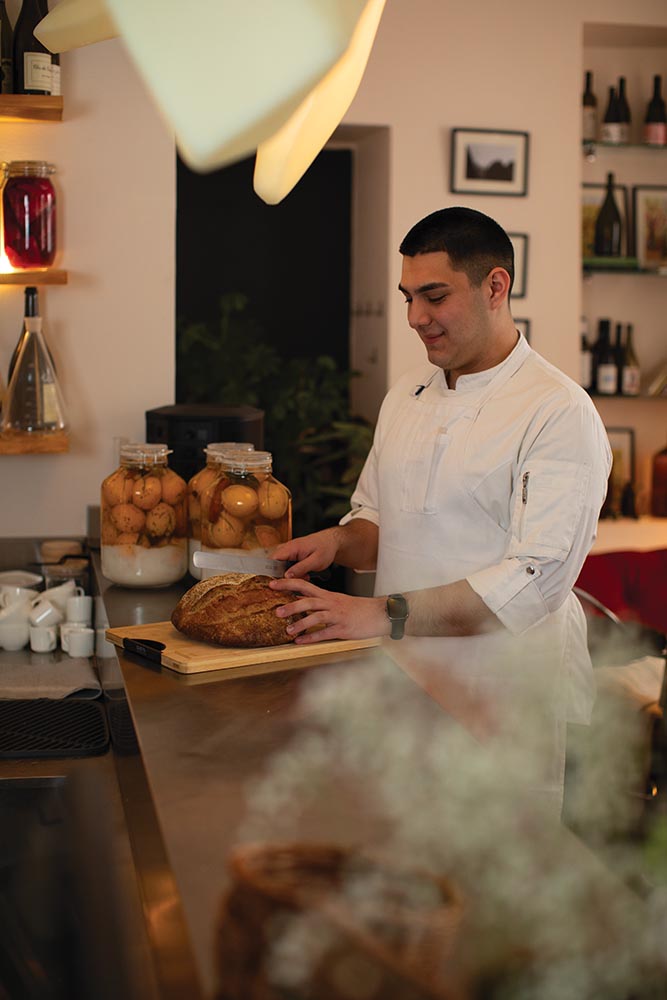
To experience this harmony, we visited Ferment, located in one of Tbilisi’s oldest neighbourhoods. The restaurant’s diverse and intriguing menu is created by the talented young chef Rezi Khundadze.
Persimmon Salad with Rachvelian Ham, Honey and Balsamic Vinaigrette, and Rkatsiteli

In Georgian cuisine, incorporating a sweet element into a salad or main dish is rare, despite the fact that we have a variety of such products available. The salad, paired with Pery winery’s Rkatsiteli, features a sweet element of overripe persimmon, enhanced with an intriguing dressing. The winemaker behind Winery Pery, and our special guest, is Rezi Tsetskhladze.
The salad’s sweetness is balanced by its salty elements and the tangy kick of the sauce, making it an excellent match for the wine. This Rkatsiteli, rich in aromas of quince, apricot, pear, sweet citrus zest, and caramelized lime, is perfectly balanced. The sweet flavours of both the wine and the salad blend seamlessly, creating a delightful lightness. The wine is velvety with a long finish, and its acidity pairs flawlessly with the salad’s sweet notes.
Rezi Tsetskhladze: Winery Pery produces wines that break away from standard norms. We adhere to traditional winemaking techniques while also embracing fresh, innovative perspectives. Pery wines are free-spirited; there are no strict rules for pairing them with dishes, though they can certainly be paired. These wines are versatile and perfect to enjoy anywhere, anytime, with any food. The core idea behind these wines was to offer exceptional quality, value, and packaging, ensuring that these three elements always harmonize.
Wood Mushroom with Poached Egg, Tarragon Emulsion, and Qvevri Kisi
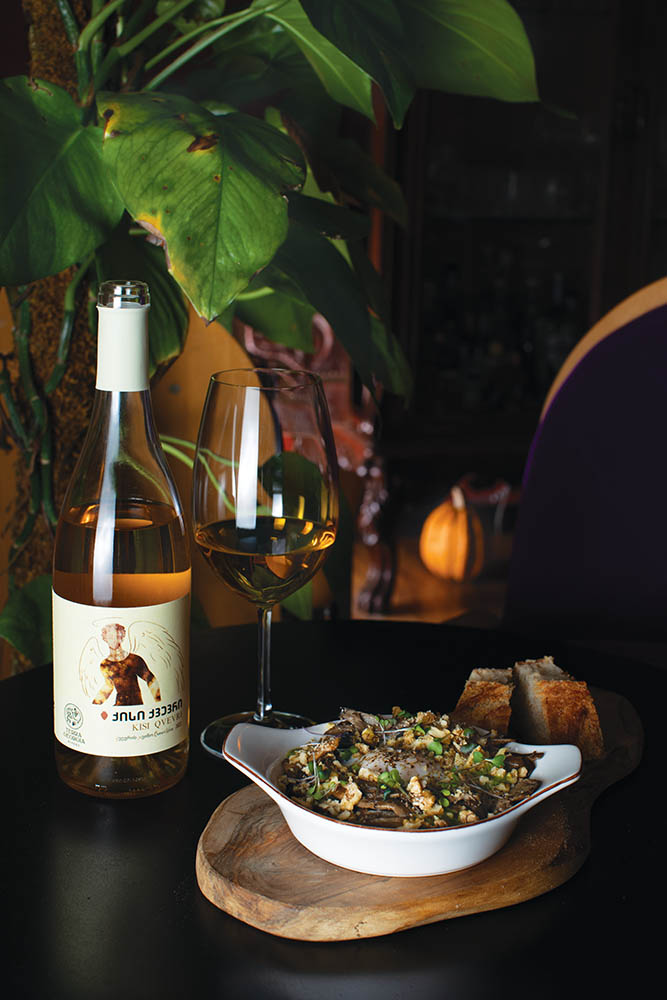
Daria Kholodilina: The amber-coloured Kisi from Terra Georgia and the wood mushroom with tarragon emulsion make for a very interesting pairing. The dominant flavour in the mushroom is umami, which is quite complex and can be, let’s say, an unfriendly component. However, this well-balanced wine, with its sweet, pleasant aromas of ripe fruit and moderate tannins, harmoniously complements it. The dish also has herbal tones that are echoed in the wine, which, for me, is the perfect pairing.
Rezi Tsetskhladze: Our goal is exactly that – to see Georgian wines widely spread in the HoReCa sector, where they can find their ideal matches with various dishes.
Chateaubriand Steak with Dauphinoise Potatoes, Pepper Sauce, and Saperavi
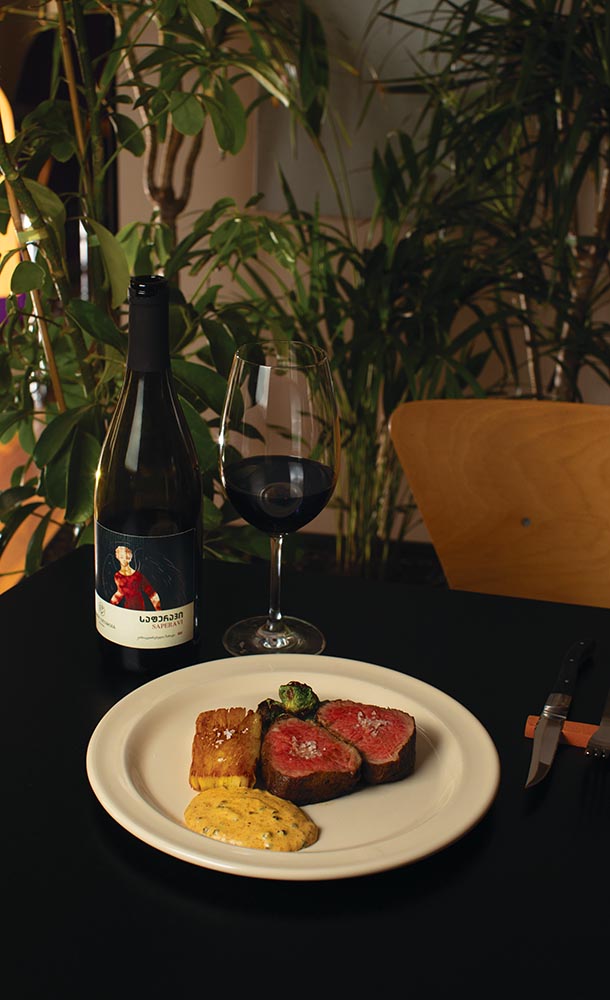
Rezi Tsetskhladze: For the delicately prepared Chateaubriand steak, cooked in a butter bath and served with vegetable garnish and sauce, we pair it with another wine from Terra Georgia, a very delicate and aromatic Saperavi. In this wine, rather than having tertiary flavours from oak-barrel aging, the dominant aromas are more varietal and derived from fermentation. Both the dish and the wine lack aggressive or dominant tastes, making this pairing a perfect match for those who appreciate both meat and red wines, as well as vegetable-based dishes and white wines. The reason is simple: both the dish and the wine are not overpowering, but rather very pleasant and harmonious.
Tazo Tamazashvili: The Saperavi from Terra Georgia is grown at the highest point of the vineyard in the village of Atskuri, Akhmeta, where we experience a contrast of hot days and cold nights. The vineyard is planted on slopes and divided into 11 distinct terroirs, each with its specific purpose. This wine is a blend of energetic Saperavi (70%) from Akhmeta and late-harvest Saperavi (30%) grown in Manavi. Both wines were fermented separately in qvevris. After fermentation, the wine matured for one year in French oak barrels, which rounded out its character and gave it a velvety structure.
Marjolaine and Fortified Wine
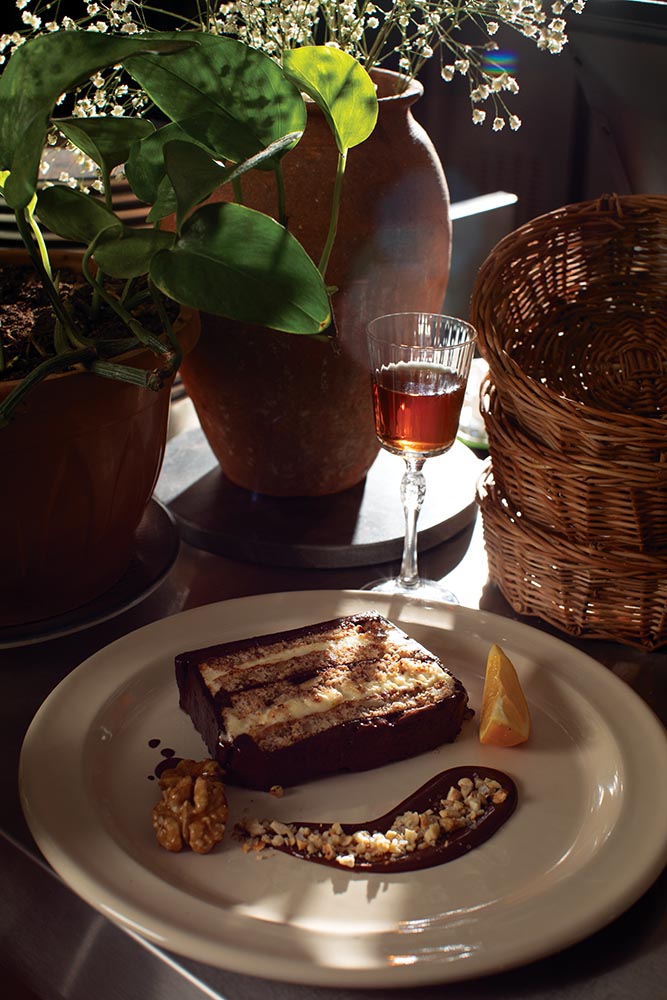
Daria Kholodilina: Pairing dessert with wine is often a debated topic. Many believe that only sparkling or rosé wines should be paired with desserts, but this is a misconception. We pair an almond cake, prepared by the chef at Ferment, with a fortified 1985 Khikhvi from the winery Kardenakhi 7. Fortified wines are produced in critically limited quantities in Georgia, despite this style of wine being highly intriguing, though not very popular locally.
The wine’s texture and flavours, especially the caramel notes, complement the delicate, velvety texture of this dessert perfectly, adding an extra layer to the chocolate-covered cake.
ქართული ღვინისა და მსოფლიო სამზარეულოს იდეალური კავშირები
თაზო თამაზაშვილი | საქართველოს საუკეთესო სომელიე
როდესაც საერთაშორისო ბაზარზე საქართველო – ქვეყანა, რომელსაც ქვევრში ღვინის დაყენების 8000-წლიანი უწყვეტი ტრადიცია აქვს – სწორედ ქვევრის ღვინოებით წარდგა, უცხოელი მომხმარებლისთვის ეს სიახლე მოულოდნელი აღმოჩნდა და მის გასაცნობად და მისაღებად დრო გახდა საჭირო. დღეს, ვხედავთ, რომ სურათი შეცვლილია – ქართული ღვინის მიმართ ინტერესი იმატებს და მოთხოვნაც მზარდია. ნატურალური მეღვინეობა მსოფლიოში ტრენდად იქცა, მათ შორის, ისეთ ქვეყნებში, როგორიც საფრანგეთი, გერმანია, ავსტრია, იტალია, ესპანეთი, აშშ, ანდა სკანდინავიის ქვეყნებია. ჩვენი ქვევრისა და ჭურის ღვინოები კი სწორედ ამ კატეგორიას განეკუთვნება.
მართალია, ქართული ღვინო უკვე მისწვდა არაერთი წამყვანი ქვეყნის ღვინის თაროს, თუმცა მნიშვნელოვან საკითხად კვლავ რჩება უცხოელი მომხმარებლის მეტად ინფორმირება, თუ რას წარმოადგენს ეს ღვინო და როგორია მისი სტილისტიკა. სხვადასხვა საერთაშორისო გამოფენასა თუ ბაზრობაზე, რომლებსაც სტუმრის, ან მონაწილის სტატუსით ვესწრები, ქართული ღვინის წარდგენის საპასუხოდ ხშირად მესმის: „პირველად ვსინჯავთ თეთრ ღვინოს, რომელიც კანთან კონტაქტით არის დამზადებული“. შესაძლოა, ამ მოსაზრებას ღვინის პროფესიონალი კი არა, მოყვარული გამოთქვამდეს, მაგრამ ისიც ვიცით, რომ სწორედ ღვინის მოყვარულები ქმნიან იმ ბაზარს, სადაც ჩვენ ღვინოს ვყიდით.
ყველა ვთანხმდებით, რომ ქართული ღვინო ღვინის პროფესიონალებსაც და მოყვარულებსაც სწორად უნდა წარვუდგინოთ და გავაცნოთ, თანაც ისეთ ობიექტებში, ფესტივალებსა თუ გამოფენებზე, სადაც ღვინო კარგად ესმით.
ჩემს კოლეგებთან ერთად – დარია ხოლოდილინა (ღვინის ექსპერტი) და რეზი ცეცხლაძე (ღვინის ექსპერტი) – გაგიზიარებთ მოსაზრებებს, რა საჭიროებების წინაშე დგას დღეს ქართული ღვინო და რა არის ის მნიშვნელოვანი ნაბიჯები, რომლებიც აუცილებლად უნდა გადავდგათ მეტი განვითარებისა და საერთაშორისო ბაზრებზე პოზიციების გასამყარებლად.
არაერთი კარგი მაგალითი გვაქვს ევროპული ქვეყნების სახით, რომლებიც სწორი სტრატეგიის მეშვეობით მსოფლიო ბაზარზე პოზიციებს სტაბილურად ინარჩუნებენ. მაგალითად, ავსტრია – ქვეყანა კარგი, მათ შორის, ნატურალური და ბუნებრივი ღვინის მწარმოებლებითა და ღვინით. თავის დროზე, აქაურმა მეღვინეებმა შექმნეს გაერთიანება/კომუნა. მათ ღვინოებს საცობებსა და ჩაჩებზე დატანილი ავსტრიის დროშით ამოიცნობთ. გაერთიანება არაერთი მნიშვნელოვანი ღონისძიების პარტნიორად გვევლინება. მათი ღვინოები ისინჯება და ფასდება მსოფლიოს საუკეთესო სომელიეების კონკურსებსა თუ სხვა მასშტაბურ ღონისძიებაზე. ეს კარგი და ყურადსაღები მაგალითია ჩვენნაირი ქვეყნისთვის, რომელსაც მართალია, ღვინის წარმოების მრავალსაუკუნოვანი ტრადიცია გააჩნია, მაგრამ ისტორიული პერიპეტიებიდან გამომდინარე, ახლა დგამს ნაბიჯებს მსოფლიო ბაზრებისკენ.
დარია ხოლოდილინა: უდავოდ მნიშვნელოვანია, უცხოელი მომხმარებელისთვის მეტი ინფორმაციის მიწოდება იმის შესახებ, თუ რა ღვინოსთან აქვს საქმე. საზღვარგარეთ ლექციების ჩატარებისას, ყოველთვის ვსაუბრობ იმ სტილისტურ მრავალფეროვნებაზე, რაც ქართულ ღვინოს გააჩნია. ქართველებს აქვთ კლასიკური ღვინის სტილი, ქვევრისა და ჭურის რამდენიმე სტილი, მრავალფეროვნებას არც წითელ ღვინოებში უჩივიან. ასეთი მრავალფეროვნება კი მუდმივად უნდა იყოს გამყარებული მაღალი ხარისხით. როდესაც ღვინის მოყვარული ირჩევს შენს ღვინოს, ხდება მისი სტაბილური მომხმარებელი, აუცილებელია, ჰქონდეს მოლოდინი, რომ ბოთლში ყოველთვის ხარისხიანი ღვინო დახვდება. ასე თუ არ მოხდა, მისი არჩევანი აუცილებლად შეიცვლება სხვა ღვინის სასარგებლოდ. ხარისხი და სტაბილურობა უმნიშვნელოვანესი ფაქტორებია განვითარებისთვის, სწორედ ისინი ქმნის შესაძლებლობას, მეტი ქართული ღვინო ვიხილოთ ევროპაში, ამერიკაში, აზიის ქვეყნებში – კორეასა და იაპონიაში. მაგალითად, აზიელი მომხმარებელი ყოველთვის ინტერესდება გასტრონომიული სიახლეებით და ტრენდებსაც ადევნებს თვალს. ამიტომაც, იაპონია და კორეა ქართული ღვინისთვის მნიშვნელოვან ბაზრებს წარმოადგენს. მათი მიმართულებით ბევრად მეტი მუშაობაა საჭირო. თანაც, ქართული ღვინო შესანიშნავად წყვილდება მრავალფეროვან აზიურ სამზარეულოსთან.
საინტერესოა სკანდინავიის ქვეყნებიც, სადაც გასტრონომიულად ცნობისმოყვარე ხალხი ცხოვრობს. ქართული ღვინო მათთვის ნამდვილ აღმოჩენად იქცევა. ასევე, დიდი ბრიტანეთი, სადაც გვხვდება ღვინის მოყვარულთა კლასტერები, რომლებიც კარგად იცნობენ კლასიკურ რეგიონებს, მაგრამ მუდმივად სურთ ახლის აღმოჩენა.
რეზი ცეცხლაძე | ღვინის ექსპერტი | მეღვინე. მეღვინეობა „ფერი“: წინ ბევრი სამუშაოა, რაც ნაბიჯ-ნაბიჯ და გააზრებულად უნდა შესრულდეს, რათა მეტად გავიმყაროთ პოზიციები მნიშვნელოვან ბაზრებზე. წლიდან წლამდე არაერთი ფესტივალი და გამოფენა ტარდება, სადაც ქართველი მეღვინეები თუ ღვინის ამბასადორები იღებენ მონაწილეობას. ჩვენს ქვეყანასაც მუდმივად სტუმრობენ ღვინის შემსყიდველები, ბლოგერები, მაგრამ ეს საკმარისი არ არის. უნდა შევეცადოთ, გადავდგათ მეტი მნიშვნელოვანი და ქმედითი ნაბიჯი, რომლებიც დამატებით შესაძლებლობას გააჩენს ქართველი მეღვინეებისთვის.
სასიცოცხლოდ მნიშვნელოვანია, საერთაშორისო ბაზრებზე სწორი პოზიციონირება და ინფორმაციის სწორად მიწოდება – მაგალითად, რას წარმოადგენს კლასიკური ტექნოლოგიით დაყენებული თეთრი რქაწითელი და რას – ქარვისფერი. მომხმარებელმა ყოველთვის მკაფიოდ უნდა იცოდეს, რა ტიპის ღვინოსთან აქვს საქმე.
თაზომ ავსტრია მოიყვანა მაგალითად, სადაც, სხვა წამყვანი ქვეყნების მსგავსად, ყველაფერს აქვს თავისი სახელი. მათგან განსხვავებით, საქართველოში, სტანდარტიზაცია არ გვაქვს, რაც, რაღაც დოზით ძალიან მომხიბლავია, რადგან ღვინის მწარმოებლებს მეტი თავსუფლება აქვთ და ამ თავისუფლებაში იბადება კიდეც ბევრი საინტერესო. თუმცა კონკრეტული ზღვრების დაწესება აუცილებლად მიმაჩნია, რათა სხვადასხვა ქვეყნის ღვინის მომხმარებლებისთვის მკაფიო გავხადოთ, რა ასხია ამა თუ იმ ბოთლში. ეს გაყიდვებს ბევრად გაადვილებს.
თაზო თამაზაშვილი: ბოლო წლების სტატისტიკა გვიჩვენებს, რომ მსოფლიოში ღვინის მოხმარება იკლებს. ასეთი პროცესები ნეგატიურად, პირველ რიგში, სწორედ ჩვენნაირ ქვეყნებზე აისახება. მრავალსაუკუნოვანი ისტორია, ქვევრში ღვინის დაყენების უნიკალური ტექნოლოგია, ჯიშური მრავალფეროვნება (525 ენდემური ჯიში), მეღვინეობის ხუთი რეგიონი, 30 ადგილწარმოშობის დასახელება – ეს უდავოდ ჩვენი ძლიერი მხარეებია, მაგრამ არ არის საკმარისი მსოფლიო ბაზარზე პოზიციების მოსაპოვებლად. საჭიროა ბევრი და სწორი მუშაობა, რათა ჩვენი ადგილი დავიკავოთ იმ სეგმენტში, სადაც ადეკვატური ფასი ექნება ქართულ ღვინოს და იქნება კონკრენტუნარიანი სხვა წამყვანი ქვეყნების საუკეთესო ღვინოებთან მიმართებაში.
პროცესზე დადებითად იმოქმედებს მეღვინეობების გაერთიანებების შექმნა, რომლებიც განსაზღვრავენ მათ შორის იმას, თუ რა ტიპურობა უნდა ჰქონდეს ამა თუ იმ ჯიშს. არ არის სასურველი, მაგალითად, იმერული ღვინო, რომელიც კახური სტილით ქვევრშია დაყენებული, პოზიციონირებდეს როგორც იმერული. ასეთ შემთხვევაში, ორი რეგიონი სტილისტურად ეჯახება ერთმანეთს და ეს არცერთისთვისაა მომგებიანი.
აღმოსავლეთ და დასავლეთ საქართველო ტერუარებით, ჯიშებით, ღვინის დაყენების ტექნოლოგიითა და სტანდარტით (აღმოსავლეთში – ქვევრი, დასავლეთში – ჭური) ერთმანეთისგან განსხვავებულია. ეს არის ჩვენი ქვეყნის კიდევ ერთი სიმდიდრე. არ არის საჭირო ერთი და იგივე სტანდარტი მოვარგოთ ყველა რეგიონს, ეს წამგებიანია.
ეს პროცესები მეღვინეთა გაერთიანებების, იგივე კომუნების მეშვეობით ყველაზე საუკეთესოდ მოექცევა შესაბამის ჩარჩოებში და ხელს შეუწყობს სტანდარტიზაციას. სწორედ ასეთმა მიდგომამ გადაარჩინა ძველი მსოფლიოს ქვეყნები მაშინ, როდესაც ახალი მსოფლიოს ქვეყნები (ავსტრალია, ჩილე, ახალი ზელანდია, არგენტინა) ბაზარზე ძალიან არომატული, ეფექტური ღვინოებით და დაბალი ფასით შემოვიდნენ, რაც მომხმარებლისთვის მისაღები აღმოჩნდა. ეს მოვლენა გახდა იმის მიზეზი, რომ ძველი მსოფლიოს ქვეყნებმა დაიწყეს მეღვინეთა გაერთიანებების ჩამოყალიბება. ამის შესანიშნავი მაგალითია თუნდაც იტალია.
საჭიროა მეტი სამეცნიერო კვლევა, რათა გამოიკვეთოს ჩვენი ჯიშების ტიპურობა და ეს არ უნდა ეხებოდეს თუნდაც მხოლოდ საფერავს. დიახ, საფერავი წამყვანი წითელყურძნიანი ვაზის ჯიშია. მისგან განსხვავებული სტილის ღვინო დგება (ის ტერუარდამოკიდებული ჯიში გახლავთ) – მუქი შეფერილობის, მაღალსხეულიანი, ტანინიანი, არომატების კონკრეტული გამით. მაგრამ საფერავთან ერთად, საჭიროა, წინ წამოვწიოთ სხვა წითელყურძნიანი ვაზის ჯიშები როგორც ცენტრალური, ისე დასავლეთ საქართველოდან. ჩვენი ქვეყანა არ უნდა იყოს ცნობილი მხოლოდ ერთი გამწევი წითელი ჯიშით.
დიდი მოთხოვნაა მსუბუქსხეულიან წითელ ღვინოებზე. საქართველოს ასეთი ჯიშების დიდი მრავალფეროვნება აქვს და შესაბამისად, პოტენციალიც, მათგან აწარმოოს ნაკლები ალკოჰოლის, მსუბუქსხეულიანი, ყოველდღიური მოხმარების ღვინოები.
თაზო თამაზაშვილი: ჩვენ ახლა გაქვს შეჯიბრის ეტაპი საერთაშორისო თაროზე, ამიტომ კარგად უნდა შევისწავლოთ ამავე თაროს პრინციპები, რათა სწორად განვსაზღვროთ ჩვენი ადგილი, თუ სად გვინდა თავის დამკვიდრება, გამოვკვეთოთ პოტენციური ბაზრები, რომელთა მიმართულებითაც უნდა გავააქტიუროთ მუშაობა. ქართველ მწარმოებლებს ევროპის, ამერიკის, აზიის ბაზრებზე პოზიციონირების მეტი შესაძლებლობა უნდა მიეცეთ, რათა ღვინის პროფესიონალებსა და მოყვარულებს ესაუბრონ მათ მიერ წარმოებულ ღვინოებზე დაწყებული ტერუარიდან, ნიადაგიდან, ჯიშიდან, დაყენების ტექნოლოგიამდე.
კერძებისა და ღვინის შეხამება
თაზო თამაზაშვილი: ქართული ღვინო შექმნილია იმისთვის, რომ მიირთვათ კარგ კერძებთან ერთად. ჩვენ ქვეყანაში არა მხოლოდ ღვინოს, არამედ გასტრონომიასაც მრავალსაუკუნოვანი ისტორია აქვს. ქართული ტრადიციული სუფრა სწორედ კერძებისა და ღვინის ერთიანობაა, ღვინო კი – ჩვენი გენეტიკური კოდი.
ქართული ღვინო იმითაც არის გამორჩეული, რომ შესანიშნავად წყვილდება როგორც ადგილობრივ, ისე ევროპულ და აზიურ სამზარეულოსთან. ეს არის გასტრონომიული ღვინო, კერძების საუკეთესო მეწყვილე.
ღვინისა და კერძების შეხამებისთვის „ფერმენტს“ ვესტუმრეთ, რომელიც თბილისის ერთ-ერთ ძველ უბანში მდებარეობს. აქაური საინტერესო და მრავალფეროვანი კერძების ავტორი ახალგაზრდა მზარეული რეზი ხუნდაძეა.
კარალიოკის სალათი რაჭული ლორით, თაფლისა და ბალზამიკოს ვინეგრეტით და რქაწითელი.

ქართულ სამზარეულოში, სალათში ანდა ძირითად კერძში ტკბილი კომპონენტის შემოტანა იშვიათობას წარმოადგენს, მიუხედავად იმისა, რომ ქართველებს არაერთი ასეთი პროდუქტი გაგვაჩნია.
სალათი, რომელსაც მეღვინეობა „ფერის“ რქაწითელთან ვაწყვილებთ, სწორედ ტკბილ კომპონენტს შეიცავს – მომზადებულია გადამწიფებული კარალიოკით და საინტერესო დრესინგიც ახლავს. მეღვინეობა „ფერის“ ავტორი და მეღვინე კი ჩვენი მოწვეული სტუმარი რეზი ცეცხლაძეა.
სალათის ტკბილი ეფექტი გრძელდება მარილიანობით და სოუსის პიკანტური გემოთი. მასთან შესანიშნავი წყვილია ეს ღვინო, რომელიც კომშის, გარგრის, მსხლის, ტკბილი ციტრუსის ცედრისა და ლიმნის შაქარლამის არომატებით არის გაჯერებული. ღვინო კარგად დაბალანსებულია და სალათის ტკბილ არომატებთან შესანიშნავ ერთობლიობას ქმნის. ღვინოსაც და კერძსაც სასიამოვნო სიმსუბუქე ახასიათებს. ეს რქაწითელი საკმაოდ ხავერდოვანია, აქვს ხანგრძლივი დაბოლოება. მისი მჟავიანობა და კერძის ტკბილი ეფექტები ერთმანეთს იდელურად ეხამება.
რეზი ცეცხლაძე: მეღვინეობა „ფერი“ ქმნის ღვინოებს, რომლებიც გასულია სტანდარტული ჩარჩოებიდან. მივყვებით ტრადიციულ მეღვინეობას და ამავდროულად, ახლებურ ხედვებსაც ვამკვიდრებთ. „ფერი“ თავისუფალი ღვინოებია, მათ კერძებთან შეხამების წესები არ აქვს, თუმცა შეგვიძლია, შევახამოთ კიდეც. ეს ღვინოები შეგიძლიათ მიირთვა ყველგან, ყოველთვის და ყველაფერთან. ღვინის შექმნის მთავარი იდეა იყო, გვქონოდა გამორჩეული ხარისხი, ფასი, შეფუთვა და ეს სამი კომპონენტი ყოველთვის ყოფილიყო ერთმანეთთან თანხვედრაში.
ხის სოკო პორშირებული კვერცხით, ტარხუნის ემულსიით და ქვევრის ქისი

დარია ხოლოდილინა: ქვევრის ქარვისფერი ქისი „ტერა ჯორჯიასგან“ და ხის სოკო ტარხუნის ემულსიით ძალიან საინტერესო წყვილია. სოკოში დომინანტი გემო უმამია, რომელიც საკმაოდ რთული, შეიძლება ვთქვათ, არამეგობრული კომპონენტია, თუმცა ეს კარგად დაბალანსებული ღვინო, მწიფე ხილის მოტკბო, სასიამოვნო არომატებითა და ზომიერი ტანინებით, ჰარმონიულად ერწყმის მას. ამავე კერძში გვაქვს მცენარეული ტონები, რომელიც ღვინოშიც მეორდება, რაც ჩემთვის იდეალური შეხამებაა.
რეზი ცეცხლაძე: ჩვენი მიზანიც სწორედ ეს არის – ქართული ღვინოები მაქსიმალურად გაიშალოს HoReCa-ში და მათ იპოვნონ თავიანთი იდეალური კავშირები კერძებთან.
შატობრიანის სტეიკი, კარტოფილის დაფინუაზით, პილპილის სოუსით და საფერავი

რეზი ცეცხლაძე: კარაქის აბაზანაში მომზადებულ შატობრიანის ნაზ სტეიკთან, რომელსაც ბოსტნეულის გარნირი და სოუსი ახლავს, „ტერა ჯორჯიას“ კიდევ ერთ ღვინოს, ძალიან დელიკატურ და არომატულ საფერავს ვაწყვილებთ. ღვინოში უფრო ჯიშური და ღუღილის შედეგად მიღებული არომატები ჭარბობს, ვიდრე მუხის კასრში დავარგების მესამეული არომატები. არც კერძსა და არც ღვინოში ვხვდებით აგრესიულ, დომინანტურ გემოებს, ამიტომ ეს წყვილი აუცილებლად მოეწონებათ როგორც ხორცეულისა და წითელი ღვინის, ისე ბოსტნეულისგან მომზადებული კერძებისა და თეთრი ღვინის მოყვარულებს. ამის მიზეზი კი ის არის, რომ კერძიც და ღვინოც არა შემაწუხებელი, არამედ ძალიან სასიამოვნო და ჰარმონიულია.
თაზო თამაზაშვილი: „ტერა ჯორჯიას“ საფერავი ახმეტის სოფელ აწყურის ვენახის ყველაზე მაღალ წერტილშია მოყვანილი, სადაც გვაქვს ცხელი დღეებისა და ცივი ღამეების მონაცვლეობა. ვენახი ფერდობებზეა შეფენილი და 11 ტერუარად დაყოფილი. თითოეულს თავისი დანიშნულება აქვს. ეს ღვინო ახმეტის ენერგიული საფერავის (70%) და მანავში მოყვანილი, გვიანი რთველის საფერავის (30%) ასამბლიაჟია. ორივე ღვინო ქვევრებში ცალ-ცალკე დადუღდა. 1 წლის განმავლობაში ვარგდებოდა ფრანგული მუხის კასრებში, რამაც ღვინო დაამრგვალა და ხავერდოვანი სტრუქტურა შესძინა.
მარჟოლეინი და შემაგრებული ღვინო

დარია ხოლოდილინა: საერთოდ, დესერტისა და ღვინის შეხამება ხშირად საკამათო საკითხია. არსებობს მოსაზრება, რომ დესერტს მაინცდამაინც ცქრიალა, ან ვარდისფერი ღვინო უნდა დავუწყვილოთ, რაც მცდარია. „ფერმენტის“ მზარეულის მიერ მომზადებულ ნუშის ნამცხვარს მეღვინეობა „კარდენახი 7“-ის შემაგრებულ, 1985 წლის ხიხვთან ვაწყვილებთ. შემაგრებული ღვინოები კრიტიკულად მცირე რაოდენობით იწარმოება საქართველოში. არადა, ამ სტილის ღვინო ძალიან საინტერესოა, თუმცა ნაკლებად პოპულარული საქართველოში.
დესერტის ნაზ და ხავერდოვან ტექსტურას ძალიან უხდება ამ ღვინის ტექსტურა და არომატები, განსაკუთრებით კი კარამელის არომატები, რომლებიც შოკოლადით შემოგარსულ ნამცხვარს დამატებითი ფენასავით ედება.


